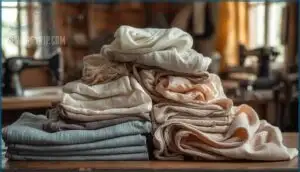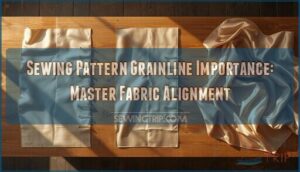This site is supported by our readers. We may earn a commission, at no cost to you, if you purchase through links.
 The first time you pull fabric off the bolt without checking its weight, you’re gambling with your entire project. A lightweight cotton that puddles beautifully in your hands might buckle under structured darts, while heavyweight denim could turn delicate gathers into stiff, awkward folds.
The first time you pull fabric off the bolt without checking its weight, you’re gambling with your entire project. A lightweight cotton that puddles beautifully in your hands might buckle under structured darts, while heavyweight denim could turn delicate gathers into stiff, awkward folds.
Fabric weight determines whether your seams lie flat, your hems drape properly, and your machine feeds smoothly without puckering or jamming. Understanding GSM and ounce measurements removes the guesswork from material selection.
When you match fabric weight to your project’s demands—considering everything from climate to construction techniques—you transform uncertain experiments into predictable, professional results.
Table Of Contents
Key Takeaways
- Fabric weight—measured in GSM (grams per square meter) or ounces per square yard—directly determines how your garment drapes, how your seams behave, and whether your machine feeds smoothly, making it the foundation of every material decision you’ll make.
- Lightweight fabrics under 150 GSM demand smaller needles (60/8 to 70/10) and shorter stitch lengths to prevent puckering, while heavyweight fabrics above 340 GSM require 90/14 needles, heavier thread, and longer stitches for durable seams that won’t snap under stress.
- Matching fabric weight to your project’s purpose—whether you’re building breathable summer dresses with 100-170 GSM materials or structured winter coats with 300-450 GSM fabrics—transforms uncertain experiments into predictable, professional results.
- Understanding the relationship between fiber properties and weight reveals why cotton absorbs 25% of its weight in moisture while linen manages only 20% but delivers 30% more strength, giving you the knowledge to choose materials that perform exactly as your project demands.
Fabric Weight for Sewing
Fabric weight isn’t just a number on a bolt—it’s the difference between a summer dress that flows and one that clings, between curtains that drape elegantly and ones that hang like cardboard.
Fabric weight determines whether your summer dress flows beautifully or clings awkwardly, and whether curtains drape elegantly or hang stiffly like cardboard
Understanding how weight impacts your sewing projects will save you from frustration, wasted materials, and garments that never quite look right.
Let’s break down why fabric weight matters, how it affects the clothes you make, and what happens when you’re actually at your machine working with different weights.
Why Fabric Weight Matters in Sewing
Fabric weight shapes everything from your first stitch to the last wear of your garment. It directly affects fabric stability—how well your material holds its shape under stress. Heavier fabrics above 300 GSM resist deformation 60% better than lighter ones, making weight selection critical for sewing challenges you’ll face at your machine.
Choose wrong, and you’ll wrestle with puckering seams or sagging hems. Get it right, and you’ve unlocked exceptional garment durability and fabric performance. Understanding this fabric weight guide transforms guesswork into confidence, whether you’re working with delicate chiffon or sturdy denim. Knowing the fabric weight classification is essential for selecting the right fabric for your project.
Importance of Fabric Weight in Garments
Your garment’s comfort, drape, and durability all hinge on weight selection. Lightweight fabrics under 150 GSM dominate 78% of summer production because they flow and breathe—perfect for warm-weather dresses. Medium-weight fabrics between 150–350 GSM give you structure and hold their shape, making up 68% of shaped pieces. Heavyweight fabrics above 350 GSM deliver outstanding fabric durability, lasting 42% longer in high-wear applications.
Understanding the fabric weight categories is vital for peak performance. Match your GSM to your vision, and you’ll transform fabric performance from unpredictable to masterful.
How Fabric Weight Affects The Sewing Process
When you shift from selecting your fabric to actually sewing it, weight dictates everything from needle choice to seam integrity. Lightweight fabrics under 150 GSM demand 60/8 or 70/10 needles and shorter stitch lengths of 1.5–2.0 mm to prevent puckering. Midweight materials need 80/12 needles and moderate tension, while heavyweight fabrics above 340 GSM require 90/14 needles, 30–40 wt thread selection, and 3.0–4.0 mm stitch length for durable seams.
Fabric stability increases with weight, but heavier textiles create more friction—use a walking foot to maintain fabric tension and consistent feeding.
What is Fabric Weight?
Fabric weight isn’t just a number on a bolt—it’s the foundation of every sewing decision you’ll make. Understanding how fabric weight is measured gives you the power to choose materials that behave exactly as you need them to.
Let’s break down the two measurement systems you’ll encounter and what they actually mean for your projects.
Definition and Measurement of Fabric Weight
When you’re standing at the fabric store, you’re not just eyeing color and texture—you’re weighing your options, literally. Fabric weight measures the mass of material per unit area, giving you a precise way to understand density and performance before you cut the first piece. This metric is expressed in grams per square meter (GSM) or ounces per square yard (OZ), with one oz/yd² equaling roughly 33.91 GSM.
Here’s what fabric weight measurement reveals:
- Fabric density impacts drape, breathability, and how well dyes saturate the fibers
- Material properties like opacity and durability scale directly with weight
- Fabric thickness doesn’t always match weight—some textiles feel substantial yet remain lightweight
Standard measurement tools include digital scales and fabric sample cutters, ensuring accurate weight conversion between metric and imperial units. Understanding these fundamentals puts you in control of every project decision.
Understanding GSM and OZ Units
Mastering these two measurement systems gives you the confidence to shop global fabric markets and execute projects with precision. GSM (grams per square meter) quantifies fabric density using metric systems—a 180 GSM cotton weighs exactly 180 grams per square meter. Imperial units measure in ounces per square yard, with 1 oz/yd² equaling approximately 33.91 GSM.
Here’s your fabric weight guide breakdown:
- Lightweight fabrics: 30–150 GSM deliver fluid drape for blouses
- Medium-weight textiles: 150–350 GSM balance structure and breathability
- Heavyweight materials: 350+ GSM provide durability for upholstery
Weight conversion between these textile measurement standards becomes second nature once you understand the relationship.
Measuring Fabric Weight
You can determine fabric weight with precision using simple tools you likely already have. Whether you’re shopping online or checking your stash at home, knowing how to measure gives you confidence in your material choices.
Let’s walk through the practical methods and resources that’ll help you calculate GSM and ounces accurately.
Tools for Measuring Fabric Weight
Accurate measurement starts with the right equipment. You’ll need a digital scale that reads to at least 0.01 grams—these scales work with standard 100 cm² circular samples cut by a GSM cutter. Professional fabric scales like the TF120 model deliver precision within ±0.01 g and meet ISO 3801 standards. For basic home sewing, a simple spring scale or digital balance works fine, though calibration methods matter for consistency. Pair your scale with digital calipers to assess fabric thickness, and you’re set for reliable weight measurements.
| Tool Type | Precision Level | Best For |
|---|---|---|
| GSM Cutter and Pad | 100 cm² samples with <0.01 mm deviation | Professional testing labs |
| Digital Scale (Fabric Weight Balance) | ±0.01 g accuracy | Precise GSM measurements |
| Spring Scale | Moderate accuracy | Home sewing projects |
| Weight Sensors | ±0.02 g in industrial models | High-volume textile production |
| Digital Calipers | Thickness assessment | Density correlation checks |
How to Calculate GSM and OZ
Calculating fabric weight yourself gives you control over material selection and project planning. The GSM calculation divides your sample’s weight in grams by its area in square meters—so a 20 cm × 25 cm piece weighing 12 grams yields 240 GSM. For OZ measurement, multiply your GSM by 0.0295 to get ounces per square yard, which helps when working with U.S. fabric suppliers.
Follow these steps for accurate fabric weight measurement:
- Cut a precise 10 cm × 10 cm sample and convert dimensions to square meters by dividing length times width by 10,000
- Weigh your sample on a digital scale that measures in grams, ensuring you account for fabric thickness and density variations
- Apply the weight conversion formula—divide grams by area for GSM, or use the conversion methods to switch between metric and imperial units
Online Fabric Weight Conversion Calculators
You don’t need to memorize conversion formulas when digital tools handle the math instantly. Online conversion calculators from platforms like TextilesBar and A&E Gütermann process over 120,000 daily queries from textile professionals worldwide, converting GSM to OZ with up to 97.8% accuracy.
These automated fabric analysis tools let you enter fabric weight in one unit and immediately see the equivalent in another, supporting both metric and imperial fabric weight standards. Most calculators offer mobile accessibility—accounting for 64% of usage—so you can verify fabric weight charts right at the cutting table.
The conversion accuracy methods built into these digital conversion tools reduce human error by 40%, making them essential for reliable conversion methods. Bookmark a reliable online calculator to simplify your fabric weight conversion workflow.
Fabric Weight Categories
Understanding fabric weight categories helps you match the right material to your project before you start cutting and sewing. These categories break down fabrics from ultra-light sheers to heavy canvas, each suited for different garments and purposes.
Here’s how the weight ranges stack up and what they mean for your sewing work.
Very Lightweight Fabrics (2.5–4 Oz)
Very lightweight fabrics—those hovering between 2.5–4 ounces per square yard or roughly 85–135 GSM—bring peerless breathability and fluid fabric drape to your summer fabrics. You’ll find cotton voile, muslin, and silk habotai in this range, perfect for sewing delicates like blouses and linings.
Their lightweight textures demand careful handling: use tissue paper beneath your cuts, smaller needles (size 60/8 to 70/10), and shorter stitch lengths to prevent puckering.
This fabric weight guide shows that mastering these airy materials unlocks beautiful projects with seamless flow.
Lightweight Fabrics (4–7 Oz)
Fabrics in the 4–7 oz range—about 135–237 GSM—strike the sweet spot for summer wear and everyday comfort. You’ll work with cotton poplin, chambray, and lightweight linen, all prized for their breathable textiles and natural fabric drape.
These lightweight fabrics sew smoothly with universal needles (size 70/10 to 80/12) and standard stitch lengths, making them forgiving for beginners yet adaptable enough for expert sewing techniques. Fabric blends like Tencel twill add softness and wrinkle resistance, ideal for shirts and flowing dresses.
Medium Weight Fabrics (7–11 Oz)
Shifting gears from lightweight staples, you’ll find medium weight fabrics—7 to 11 oz or roughly 170–340 GSM—positioned right in the fabric durability sweet spot. These midweight textiles form the backbone of year-round wardrobes, blending structure with comfort in ways lighter materials can’t match.
When you’re making weight selection decisions, medium weight fabrics deliver:
- Flexible construction for both casual trousers and structured dresses
- Reliable fabric durability that withstands frequent wear without sacrificing drape
- Easier sewing techniques with standard needles and stitch lengths
- All-season adaptability that reduces your fabric weight guide confusion
Velvet, twill, ponte, and denim all sit comfortably in this range. Your fabric blends here—think cotton canvas at 10 oz or wool suiting—require minimal adjustments to your machine setup while offering excellent longevity over their lighter cousins.
Heavyweight Fabrics (11–14 Oz)
When your projects demand serious structure and long-lasting wear, heavyweight fabrics—ranging from 11 to 14 oz or 340–400 GSM—deliver the fabric density and textile strength you need. These heavy fabrics excel in workwear, structured coats, and upholstery, where durability is paramount.
While sewing with these fabrics presents challenges, such as adjusting thread tension and using heavy-duty needles, the results are well worth the effort. Garments made from heavyweight fabrics maintain their shape and outlast lighter alternatives by years.
| Fabric Type | Common Uses |
|---|---|
| Denim & Canvas | Work jackets, durable jeans |
| Wool Coating | Structured blazers, winter coats |
| Jacquard & Brocade | Upholstery, formal garments |
| Ponte & Twill | Structured skirts, professional attire |
Very Heavy Fabrics (14–18 Oz+)
When you’re ready to tackle workwear, industrial tarps, or winter coats that last for years, very heavy fabrics weighing 14–18 oz (475–610 GSM) bring exceptional fabric density and structural integrity. These industrial textiles—like bull denim, duck canvas, and wool coatings—handle durability testing with tensile strengths exceeding 300 lbf and abrasion resistance surpassing 65,000 double rubs. Their thick weaves demand industrial-strength machines, 90/14 to 100/16 needles, and longer stitch lengths (3.5–4.0 mm), but the payoff is gear that withstands brutal conditions.
- Canvas & denim (14–18 oz): Work jackets, heavy-duty bags, tool aprons
- Wool coatings (16+ oz): Structured winter outerwear, duffel coats
- Treated marine canvas: Tarps, outdoor covers with 1,200+ mmH₂O water resistance
- Upholstery fabrics: Durable slipcovers, commercial-grade seating
- Luggage & gear: Backpacks, utility pouches built to endure heavy loads
Choosing The Right Fabric Weight
Choosing the right fabric weight isn’t guesswork—it’s about matching material to purpose. Your project’s success depends on understanding how weight influences drape, durability, and wearability.
Let’s break down the key factors you’ll need to take into account before making your selection.
Factors Influencing Fabric Weight Selection
When you’re ready to pick fabric, think beyond the pattern envelope—your choices should align with garment purpose, drape expectations, and the seasonal demand you’re designing for. Fabric density directly impacts whether your project flows softly or stands with structure, while sewing challenges multiply when you mismatch weight with technique.
A fabric weight guide helps you navigate categories and factors influencing fabric selection, from breathability needs in summer wear to durability demands in outerwear. Choosing the right fabric weight means balancing climate, intended use, and your comfort level at the machine.
Specific Material Weight Comparison
Understanding fiber properties reveals how material composition shapes performance beyond simple numbers. Cotton absorbs up to 25% of its weight in moisture, while linen—about 30% stronger—manages only 20% but excels in durability through longer, tightly woven fibers.
For practical textile analysis:
- Linen vs. Cotton: Very fine linen starts at 80–90 gsm; cotton lawn and poplin reach 150 gsm. Linen’s weight factors include stronger fibers, while cotton offers enhanced moisture absorption.
- Denim vs. Canvas: Denim averages 11–12 oz with breathability; canvas sits around 9 oz with wind resistance through tighter weaving. Canvas delivers more strength per ounce, but denim’s heavier weights balance durability in fabric weight categories.
- Wool vs. Polyester: A 150 gsm wool tee insulates better than cotton at similar fabric density. Polyester base layers stay under 150 gsm for quick-drying performance, while winter wool coatings reach 600 gsm for extreme cold—this specific material weight comparison matters when fabric weight and sewing intersect with climate demands.
Project Type and Fabric Weight
Your sewing project shapes every fabric weight decision you make. Ultra-light fabrics under 100 GSM suit scarves and linings, while summer shirts and dresses thrive with lightweight materials between 100–170 GSM.
Midweight fabrics (170–340 GSM) deliver reliable structure for pants, jackets, and uniforms—ideal territory for building garment durability without sewing challenges.
Heavyweight options above 340 GSM anchor jeans, coats, and workwear where fabric selection for projects demands serious strength.
Match your project planning and weight considerations to these fabric weight categories, and you’ll nail fabric weight and sewing every time.
Climate and Fabric Weight
Climate shapes your fabric weight choices more powerfully than most sewists realize. In warm regions, 82% of garment makers reach for lightweight fabrics under 150 GSM—summer clothing fabrics like breathable cotton and airy linen that let heat escape naturally. When winter bites, you’ll need heavyweight fabrics between 300-450 GSM, especially wool blends that trap warmth and deliver thermal comfort in subzero conditions. Regional trends show that tropical zones favor ultra-light materials for maximum breathability, while northern climate zones demand serious fabric density for insulation.
Your seasonal fabrics arsenal should include:
- Ultra-lightweight options (<100 GSM) for hot, humid environments
- Midweight versatility (170-340 GSM) for transitional weather
- Heavyweight protection (350+ GSM) for cold-weather garments
- Layered combinations for unpredictable climate zones
Typical Fabric Weights for Garments
Once you’ve narrowed down your fabric choice, matching it to the right garment type makes all the difference. Different clothing items work best with specific weight ranges, and understanding these benchmarks will help you avoid fabrics that are too flimsy or too stiff for your project.
Here’s how fabric weights generally break down across garment categories.
Lightweight Garments (0-150 Gsm)
Lightweight fabrics below 150 GSM bring comfort and breathability to your summer wardrobe. These airy textiles—chiffon at roughly 40 GSM, voile around 50–100 GSM, and cotton lawn near 70 GSM—offer outstanding fabric drape that flows naturally with movement.
You’ll find them ideal for hot-weather blouses, sundresses, and layered garments where breathable textiles matter most.
Keep in mind that their delicate nature requires careful sewing techniques: use fine needles (size 60/8 to 70/10) and gentle handling to prevent distortion while stitching.
Medium Weight Garments (150-300 Gsm)
Medium weight fabrics spanning 150–300 GSM serve as your foundational workhorse for garment construction, balancing structure with breathability. Cotton poplin at 150–200 GSM and twill around 180–300 GSM give you reliable fabric selection options for T-shirts, casual dresses, and chinos—textile properties that account for roughly 60% of apparel use.
These midweight fabrics handle well under needles sized 80/12 to 90/14, making fabric manipulation straightforward whether you’re tackling structured blazers or flowing skirts that need moderate drape without excess bulk.
Heavyweight Garments (300+ Gsm)
When fabric density climbs above 300 GSM, you’re working with heavyweight textiles built for garment durability and thermal insulation—think winter coats, denim workwear, and upholstery that won’t quit.
These heavy weight fabrics demand sewing challenges like industrial needles, slower stitch speeds, and walking feet to manage the bulk, but they reward you with structures that resist wind, retain heat, and outlast lighter alternatives by years.
Fabric Weight for Home Decor Projects
Your home furnishings deserve the same precision you bring to garment construction. Curtain weight starts around 80–350 GSM—lighter for sheers that filter morning light, heavier for blackout drapery that insulates winter rooms.
Upholstery fabric demands 300–600 GSM minimum, giving sofas and armchairs the structural integrity to survive daily use.
Decorative textiles like cushion covers sit comfortably at 200–400 GSM, balancing comfort with tear resistance.
When fabric durability matters, remember that higher GSM values translate directly to better wear-test scores—your fabric weight guide to projects that last.
Fabric Weight and Sewing Techniques
Once you’ve dialed in your home decor projects, the real mastery begins. Needle selection shifts everything—fabrics below 150 GSM work best with 60/8 to 70/10 needles, while heavyweight materials above 250 GSM need 100/16 to 110/18 sizes to punch through without breaking.
Adjust your stitch length longer for thick fabrics to prevent skipped stitches, and dial thread tension between 4–6 for denim but drop it to 2–4 for delicate voile.
Seam reinforcement matters too: flat-felled or French seams give heavy fabrics the durability they need, while lightweight materials benefit from rolled hems that control fraying without bulk.
Choosing The Right Sewing Machine for Fabric Weight
Your machine selection starts with understanding fabric compatibility. Domestic machines handle materials up to 200 GSM comfortably, but heavier fabrics—think denim or canvas above 12 ounces—require industrial models with motors reaching 550 watts and reinforced frames.
Needle choice and thread tension adjustments become critical as you move between weights. Lightweight fabrics below 90 GSM need 65/9 to 75/11 needles with lower tension, while heavyweight materials demand 100/16 or larger needles and higher tension settings to maintain sewing performance without thread breakage.
Fabric Weight and Pattern Requirements
Beyond machine capabilities, your pattern selection defines project success through its fabric weight specifications. Patterns designed for lightweight materials under 150 GSM demand drapey textiles like chiffon, while midweight patterns (170–340 GSM) work best with twill or Tencel for balanced structure.
When you substitute heavier or lighter fabrics than recommended, garment fit can shift up to 10% due to drape differences. Pattern adjustments become necessary—increase ease by 2–3% when switching to heavyweight materials, and modify seam finishes to match your fabric selection.
French seams suit fabrics under 150 GSM, while flat-felled seams handle weights above 300 GSM for proper garment construction.
Converting Between GSM and OZ
You’ll often see fabric weights listed in both GSM and ounces per square yard, depending on where you’re shopping or what pattern you’re using.
Converting between these two units doesn’t require complicated math—you just need to know the basic conversion factor.
Here’s how to handle conversions quickly, whether you’re calculating by hand or using digital tools.
Easy Conversion Methods for Sewists
Converting fabric weight doesn’t have to feel like cracking a code. With the right tools at your fingertips, you’ll switch between GSM and OZ effortlessly. Keep a printed conversion chart near your workspace, bookmark reliable fabric calculators, or download sewing apps for instant reference. These conversion methods save time and eliminate guesswork when selecting materials.
- Weight charts list common conversions—70 GSM equals 2.0 oz/yd², 250 GSM equals 7.37 oz/yd²
- Fabric calculators provide instant results when you input either measurement unit
- Sewing apps offer offline access to conversion tools while shopping or measuring fabric weight
- Measurement tips include verifying calculations with sample swatches for accuracy
How to Convert GSM and OZ by Yourself
You can master fabric weight measurement methods with three simple calculation steps. First, measure your fabric sample in meters—say, 20 cm × 25 cm equals 0.05 square meters. Second, weigh it using a digital scale accurate to 0.01 grams. Third, apply the conversion formulas: divide grams by area for GSM, then divide that result by 33.906 for ounces per square yard.
If your 0.05 m² swatch weighs 12 grams, you’ll calculate 240 GSM or 7.08 oz/yd². This hands-on approach gives you complete control over understanding fabric density and weight measurement for any project.
Using Online Fabric Weight Conversion Calculators
With a fabric weight calculator at your fingertips, you’ll handle GSM and OZ conversion with confidence. More than 70% of textile professionals rely on these digital tools for quick, accurate conversions—and you should too. Most calculators use the standard formula (1 oz/yd² ≈ 33.91 GSM) with calculator accuracy generally below 2% error when you input precise measurements.
Here’s what makes these online resources so valuable:
- Instant conversion between units – Enter your fabric weight in GSM, and you’ll get OZ results immediately, streamlining your fabric analysis workflow.
- Multi-unit support – Many platforms convert linear meter weight, yardage, and offer downloadable conversion tips for studio reference.
- Mobile accessibility – Over 92% of leading calculators work on your phone, so you can check fabric weight measurements right at the store or cutting table.
These fabric weight conversion tools transform complex calculations into simple clicks.
Working With Different Fabric Weights
Each fabric weight demands its own approach at the sewing machine. The techniques you’ll use for a featherlight chiffon differ completely from those required for heavy canvas or denim.
Here’s how to handle lightweight, heavyweight, and medium-weight fabrics with confidence.
Tips for Working With Lightweight Fabrics
Working with ultra-lightweight fabrics demands patience—these delicate textiles respond poorly to rushed handling. Your fabric selection starts with proper needle choices: a size 70/10 Microtex needle minimizes damage and delivers higher precision.
For fabric handling, support the material while moving it through your machine to reduce stretching risks. Cut one layer at a time using a rotary cutter for accuracy, and stabilize with tissue paper beneath to prevent slippage.
Stitch optimization matters—set your machine to 2 mm length to avoid puckering. This lightweight fabrics approach, guided by GSM understanding, ensures professional results every time.
Techniques for Working With Heavyweight Fabrics
When dense textiles challenge your machine, proper setup makes all the difference. Start with a 100/16 or 110/18 needle paired with Tex 70 bonded polyester thread for heavy fabric sewing. Extend stitch length to 3 mm and reduce presser foot pressure to prevent bunching during thick material handling.
Use sewing clips instead of pins to avoid punctures, and employ a walking foot for even feeding across layers.
Flatten seams with a tailor’s ham, then press with high heat—this bulky seam management transforms challenging projects into controlled, professional results.
Best Practices for Sewing With Medium Weight Fabrics
Your machine’s tension dial and needle choice determine whether your project flows smoothly or fights you at every seam. Set tension between 4.0 and 5.0, and pair universal or sharp needles sized 80/12 to 90/14 with 40–60 weight polyester thread for fabric handling success.
A 2.5 to 3.0 mm stitch length delivers balanced seams in cotton twill and linen without puckering.
Press as you sew—this simple fabric selection step reduces rippling and sets seams properly in medium weight fabrics ranging from 7 to 11 oz, transforming your sewing techniques and garment construction outcomes.
Frequently Asked Questions (FAQs)
How much does fabric weigh?
What’s hiding in a yard of silk versus a square of denim? Weight reveals everything. Fabric density ranges dramatically—from whisper-light chiffon at 5 oz/yd² to sturdy canvas exceeding 18 oz/yd².
Most everyday material thickness falls between 4-11 oz/yd², measured in grams per square meter (GSM) or ounces.
How do you measure fabric weight?
To measure fabric weight, you’ll need a digital scale and measuring tape. Weigh your fabric sample in grams, measure its dimensions in meters, then divide the weight by the area to calculate GSM (grams per square meter).
This calculation method provides accurate fabric density measurements for any textile project.
How much does a medium-weight fabric weigh?
Medium-weight fabrics generally weigh between 150-350 GSM (approximately 5-10 oz per square yard). This fabric density offers an ideal balance—enough structure for everyday garments without feeling heavy.
You’ll find midweight materials like twill, linen, and jersey work well for shirts, dresses, and light jackets year-round.
What is quilting weight fabric?
Like a sturdy bridge between delicate silks and heavy canvas, quilting weight fabric stands as the workhorse of your sewing project arsenal.
Quilting cotton properties include a balanced weave at 140-160 GSM—dense enough for precise piecing yet manageable on home machines. Best cotton brands deliver this midweight sweet spot, where fabric weave impact meets durability without bulk, making it perfect for quilting applications beyond just blankets.
How much does a suiting fabric weigh?
Suiting material generally falls between 150-350 GSM (roughly 5-11 oz/yd²), with fabric density directly affecting garment durability and seasonal suitability.
Lighter weight ranges around 210-230 GSM work year-round, while heavier suit weight fabrics exceeding 340 GSM provide winter insulation.
How heavy should fabric weights be?
There’s no one-size-fits-all answer—choosing fabric weight depends entirely on your project’s purpose. Lightweight fabrics (5–4 oz or under 150 GSM) work best for flowing garments like blouses, while medium-weight materials (7–11 oz or 200–340 GSM) suit everyday wear.
Heavyweight fabrics (11–18 oz or 340+ GSM) deliver the textile strength and material thickness needed for upholstery, bags, and outerwear, though they present sewing challenges requiring specialized needles and techniques.
What are the fabric weight categories?
Fabric weight categories divide textiles into five distinct ranges based on material selection and textile science. Very lightweight fabrics (5–4 oz or under 150 GSM) suit delicate projects, while lightweight fabrics (4–7 oz or 150–200 GSM) work for blouses and summer garments.
Medium weight fabrics (7–11 oz or 200–270 GSM) provide structure for everyday wear. Heavyweight fabrics (11–14 oz or 270–350 GSM) handle outerwear and workwear, and very heavy fabrics (14–18+ oz or 350+ GSM) tackle upholstery and durable goods.
Understanding these weight ranges helps you match fabric density to your sewing techniques and project requirements.
How do you determine fabric weight?
You determine fabric weight by cutting a precise one-meter square sample and weighing it on a calibrated digital scale—this gives you the GSM (grams per square meter).
For material thickness and fabric density, use a scale with 01-gram accuracy to guarantee proper weight measurement. Calibration methods maintain scale accuracy throughout your fabric weight guide.
Is 10 oz of fabric heavy?
At 10 oz per square yard, you’re working with heavyweight fabric—dense, durable, and built for structure.
This weight classification suits denim, canvas jackets, and sturdy upholstery projects where fabric opacity and strength matter most.
Can fabric weight affect pattern sizing and layout?
Here’s the skinny: Fabric weight shapes Pattern Ease and Layout Efficiency. Heavier fabric means greater Seam Allowance and more spread-out pieces, while lightweights drape closer—saving space and shifting sewing techniques for smooth garment construction.
Conclusion
Choosing the wrong weight isn’t just a minor miscalculation—it’s the difference between wasted hours and work you’ll wear proudly for years. Once you master this fabric weight guide for sewing, you’ll walk into any fabric store knowing exactly what your project demands.
You’ll measure with confidence, match GSM to construction techniques, and avoid the heartbreak of beautiful fabric that simply won’t cooperate. Your needle settings, your seam finishes, your finished drape—everything improves when weight becomes your compass instead of your blind spot.
- https://favouritehub.com/gsm-calculation-using-different-units-metric-imperial-formulas/
- https://blog.fabricuk.com/understanding-fabric-weight/
- https://www.allieolson.com/blogs/blog/fabric-files-demystifying-fabric-weight
- https://idcustomapparel.com/understanding-fabric-density-dtex-and-denier/
- https://store.astm.org/products-services/standards-and-publications/standards/textile-standards.html

















